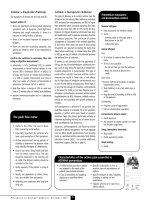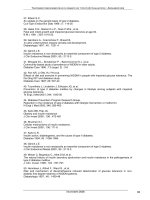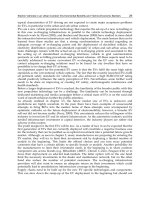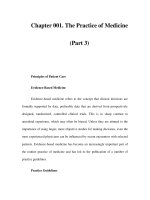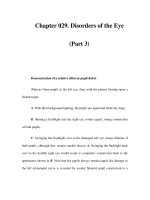The Ophthalmology Examinations Review - part 3 ppt
Bạn đang xem bản rút gọn của tài liệu. Xem và tải ngay bản đầy đủ của tài liệu tại đây (1.66 MB, 44 trang )
TOPIC
I0
MEDICAL TREATMENT
OF
GLAUCOMA
What
is the ideal drua
for
glaucoma?
‘The ideal drug carries certain characteristics
”
Ideal drug
1.
Effective (in lowering
IOP)
2.
Active on multiple fronts (decrease production, increase outflow,
neuroprotective)
3.
Minimal side effects
4.
Convenient dosage
5.
Relatively inexpensive
What
are the current drugs available for treatment
of
alaucoma?
“Current drugs available can be classified according
to
their effectiveness
in lowering
IOP
”
Effectiveness in lowering IOP Examples
Class
I(30%
reduction in IOP)
Beta blockers
Latanoprost
Alpha
2
agonist (brimonidine)
Unoprostone
Class
II
(20%)
Pilocarpine
Dorzolamide
Alpha agonist (apraclonidine)
Beta
1
blockers (betoptic)
Class
111
(1 0%)
Propine
Other older alpha agonists
“What
IS
the ideal
74
Section
2:
Glaucoma and Glaucoma Surgery
75
What
are the traditional drugs for treatment
of
qlaucoma?
Traditional drugs
Drug Pharmacodynamics Effectivenesdadvantages Side effects
Beta blockers (timolol)
Decrease aqueous
production
0
Twice daily dosage
(T1/2
=
12
hours)
Concentration:
0.25
0
and
0.5%
0
Class
I
prototype
30%drop
in
IOP
in
80-90%
of patients
(e.g.
24
to
16mmHg)
Good compliance
Additive effects with
pilocarpine but not with
sympathetic agents
Cheap
Miotics (pilocarpine)
0
Sympathetic agents
(adrenaline and
propine)
Increase aqueous Class
II
prototype
drainage
(miosis
20%
drop
in
IOP
with opening of angle Additive with beta
and contraction of blockers and
longitudinal fibers sympathetic agents
of
ciliary body) Cheap
Four times daily
dosage
Concentration:
1-16%
Decrease aqueous
production
0
(alpha
2
effect)
0
Increase aqueous
drainage
(beta
2
effect)
0
Twice daily dosage
Concentration: 0.5%
1%,
2%
(adrenaline)
Concentration:
0.1%
(propine)
Class
Ill
prototype
10%
drop
in IOP
Additive effects with
pilocarpine
but
not with
beta blockers
Cheap
Mild local side effects
(decrease corneal sensation,
allergic reaction, cicatricial
conjunctivitis)
Severe systemic side effects
(pulmonary bronchospasm,
bradycardia, hypoglycemia)
Common systemic side
effects (lethargy, decreased
libido, depression)
Miosis (impairment
of
night
vision)
Myopia and headache (spasm
of accommodation from
circular muscle contraction)
Retinal detachment
(longitudinal muscle
contraction)
ability for blood-aqueous
barrier)
Angle closure glaucoma
Uveitis (increased perme-
Allergic conjunctivitis (20% in
one year,
50%
in 5 years)
Angle closure glaucoma
Adrenochrome deposition
Aphakic cystoid macular
edema
Risk factor for trabeculectomy
failure
Carbonic anhydrase
inhibitors (Diamox)
Decrease aqueous
Effect independent of
production
(inhibits
IOP
levels
0
carbonic anhydrase) Useful for short term
OralllV treatment
Concentration:
0
250 mg/500 mg
0
0
0
Tingling of fingers and toes
Renal (metabolic acidosis,
hypokalemia and renal
stones)
Gastrointestinal symptoms
Steven Johnson’s syndrome
Malaise, fatigue, weight
loss
Bone marrow suppression
(aplastic anemia)
76
The Ophthalmology Examinations
Review
What
are the new drugs for treatment of glaucoma?
New drug
Drug Pharmacodynamics
Eff
ectivenesdadvantages Side effects
Latanoprost PGF2alpha agonist
(Xalatan)
Increase uveoscleral
outflow
Once nightly dosage
(T1/2
=
12 hours)
Concentration:
0.005%
.
Better or as effective as
timolol (depending on which
study)
Class
I
drug.
30%
drop in
IOP
in
80-90%
of patients
(e.g. 24
to
16 mmHg)
IOP
effect at night
Good compliance
Additive effects with
other medications
Effective for 2 years with no
drift
Brimonidine Alpha 2 agonist
-
3
(Alphagan) effects
1.
Decrease aqueous
2. Increase uveoscleral
3.
Neuroprotective
Twice daily dosage
Concentration: 0.2%
Rapid onset
(30
min)
production
outflow
Class
I
drug
Alpha 2 selectivity -aqueous
production suppression
(without vasoactivity effects
of alpha 1)
*
Less side effects compared
to
older non-specific alpha
agonists (apraclonidine)
1.
Tachyphylaxis
(30%)
2. Chemosis and stinging
Additive effects with other
(30%)
medications
Little systemic SE (T1/2 in plasma
=
Conjunctival injection (10% will
complain of redness,
30%
objective
injection)
Inflammation (contraindicated in
uveitis)
Hypertrichosis (increase in length,
number and thickness)
Iris
pigmentation (melanin deposition,
no melanocyte hyperplasia, therefore
no risk
of
melanoma)
Cystoid rnacular edema
(pseudophakics/aphakics)
Expensive
Allergic blepharoconjunctivitis (1
0%)
Corneal irritation (10%)
Dry mouth
(10%)
7
s)
Dorzolamide Topical carbonic
Class
II
drug Injection and stinging
(30%)
(Trusopt) anhydrase inhibitor
Less side effect compared
to
Less effective than timolol
Only
1/3
as effective
oral
Corneal opacification
in
Three times daily endothelial pump function
Concentration: 0.2%
as oral compromised corneas (inhibits
dosage
Unoprostone
PGF2alpha metabolite
Class
I
drug Similar
to
Latanoprost
(Rescula) agonist
As effective as timolol
1. Increase
May also increase optic
conventional outflow nerve head perfusion
2. Increase uveoscleral
outflow
Twice daily dosage
Concentration: 0.12%
TOPIC
I
I
LASER THERAPY
FOR
GLAUCOMA
Whatare the uses of lasers for glaucoma?
"Lasers can be used for diagnostic and therapeutic purposes."
"Therapeutic use can be divided anatomically into
"
1.
Diagnostic
Confocal scanning laser ophthalmoscope (optic nerve head
evaluation)
Laser retinal doppler flowmetry (optic nerve head perfusion)
2.
Therapeutic
Anatomical Procedure name Type
of
Indications
site laser
Notes
Iris Peripheral Nd: YAG or 1.
iridotomy (PI) sequential 2.
3.
Argon-YAG
Laser
iridoplasty
Argon 1.
2.
3.
4.
5.
Laser Argon As
pupilloplasty
PACG
Narrow, occludable
angles
Secondary ACG
(phacomorphic, uveitic)
Medically unresponsive
PACG
Angle crowding
Plateau iris
Laser
PI
block
Prior to ALT in POAG
with narrow angles
in laser iridoplasty
Settings:
Argon (l.lW, 0.05s, 50pm)
followed by Nd: YAG (2-3mJ)
Lens:
Abraham's or Wise's
Laser 1 ring around iris (stretches
angles and dilates pupil
to
relieve
pupil block)
Laser 3 rings around pupils
(dilates pupil
to
relieve pupil
block)
Angles Laser Argon Temporizing procedure that Settings:
trabeculoplasty
(ALV Less effective than medica- Extent:
tends
to
fail in the long term
ations and surgery in
VF
preservation Number of shots:
1.
Medically unresponsive
40
POAG
2. Pigment dispersion and
pseudoexfoliation
3. Elderly patient not fit for
surgery
Argon (0.2W, O.ls, 50pm)
180
or 360 degrees
77
70
The Ophthalmology Examinations Review
Anatomical Procedure name Type
of
Indications
site laser
Notes
Laser trabeculo- Argon Neovascular glaucoma Laser new vessels at iris
coagulation
Ciliary body Ciliary body Diode Refractory glaucomas What about cryotherapy?
ablation (1.8-2
W)
1.
Neovascular Advantages of laser, lower risk
1.
Transcleral Continuous
2.
Uveitic
of
cyclophotoco- wave YAG 3. Traumatic 1. Phthsis bulbi
agulation (TCP)
(8-9
W)
4.
Failed trabeculectomy
2.
Sympathetic ophthalmia
2.
Transpupillary
5.
Congenital 3. Chemosis and pain
CyclOphotOCO-
aguation
Sclera Laser sclerostomy Holium POAG
YAG
Makes
300
bm hole in sclera
Little collateral damage because
using picoseconds pulses
High incidence of failure
Laser suture lysis Argon Post-trabeculectomy (useful Settings:
1-3 weeks after trabeculec-
tomy
to
improve filtration)
Argon
(0.2W,
O.ls, 50um)
Lens: Hoskins
Vitreous
YAG
capsulotomy Nd: YAG Malignant glaucoma Settings:
for
malignant
glaucoma Lens:
YAG (2-2.5mJ,
1
pulse per burst)
capsulotomy lens
HO
Wdo
you
perform cyclodestruction
using
laser?
“I
would use a diode laser
to
perform a transcleral cyclophotocoagulation (TCP).”
Diode
TCP
1.
Procedure
Retrobulbar anaesthesia
Contact fiber-optic probe
Settings:
1.8
to
2
W
0.5s
30-40 shots
2.
Post
procedure
Analgesics
Steroids
Extent:
360
degrees 1-3mm from limbus
Hear “pop” sound (microablation
of
ciliary body epithelium)
Check IOP
3
weeks later
When
do vou perform laser peripheral
iridotomv
(PIP
“The laser peripheral iridotomy is indicated for therapeutic and prophylactic purposes.”
Section
2:
Glaucoma and Glaucoma Surgery
79
Indications for laser peripheral iridotomy
1. Therapeutic
POAG with narrow angles
Narrow occludable angles
PACG (acute ACG, intermittent ACG, chronic ACG)
Secondary ACG (irido-IOL block, irido-vitreal block, subluxed lens with pupil block)
Fellow eye of patient with PACG
2.
Prophylactic
HOW
do you perform laser
PI?
“I
would perform a Nd: YAG laser
PI
as follows
”
or
“I
would perform a sequential Argon YAG laser
PI
as follows
’I
Procedure for laser peripheral iridotomy
1.
Prepare the patient
Miosed pupil with 2% pilocarpine
lnstil
1%
apraclonidine
1
hour before procedure
Topical anesthetic and position patient at laser machine
2.
3.
Abraham’s iridotomy lens
4.
Location
of
PI
Upper nasal iris
(to
avoid diplopia and macular
burn)
1/3
distance from limbus
to
pupil
Iris crypt if possible
Apply 20-30 burns until iris is penetrated
Plomb of iris pigments
Deepening of AC
6.
7.
Post procedure
lnstil
1%
apraclonidine
Argon blue green laser settings:
1.1
W,
0.05s,
50pm
5.
Signs
of
penetration
Retroilluminate to see patent PI
Gonioscopy to see opened angles
Nd: YAG laser setting:
2.5mJ,
3-5
shots
PI
size ideally should be
300-500pm
Check
IOP
1
hour later
Topical steroids for
1
day
Whatare the corndications
of
laser PI?
Complications
1.
Contiguous damage
Corneal burn
Cataract
Iris bleeding
lritis
Increased
IOP
2.
Iris
3.
Malignant glaucoma
4.
Monocular diplopia
v
“What are the unique features of the
Abraham’s iridotomy lens?”
Contact lens with
+66D
lenticule
Stabilize globe during procedure
High magnification
Increases cone angle and energy
at site by
4X
Therefore, the
spot
area
is effectively reduced
4X
and radius reduced
2X
(square root of
4)
(Le.
50pm
spot size
is
reduced to 25pm)
In addition, the energy
around cornea and iris
is reduced by
4X
TOPIC
I2
SURGICAL
TREATMENT
FOR
GLAUCOMA
Clinical exam:
What
are the indications
of
trabeculectomy
in
glaucoma?
“There are no absolute indications for trabeculectomy
”
“In general
”
“Common scenarios include
”
Indications
1.
2.
3.
Common scenarios include
Treatment should be individualized with no fixed rule
General principle: When
IOP
is raised
to
a level that there is evidence of progressive
VF
or
ON
changes which will
threaten the quality of visual function, despite adequate medical treatment
Uncontrolled POAG with maximal medical treatment
Failure of medical treatment (IOP not controlled with progressive VF or ON damage)
Side effects
of
medical treatment
Noncompliance with medical treatment
Additional considerations
Young patient with good quality of vision
One-eyed patient (other eye blind from glaucoma)
Family history of blindness from glaucoma
Glaucoma risk factors (HPT, DM)
Secondary OAG or ACG
Uncontrolled PACG after laser
PI
and medical treatment
HO
Wdoes medical compare with surgical
therapy
in
glaucoma?
“It
is difficult to compare medical with surgical treatment, with
new research showing both have advantages and disadvantages.
We can compare the two in
4
major areas
”
Medical treatment Surgical treatment
Effectiveness
40%
respond readily and consistently
to
low
dose medicine
50% eventually require complex medical
regimen, adjuvant ALT and filtration surgery
5-10% poor response
to
medical treatment in
first instance and require surgery
Improved surgical technique has led to
80-90%
success rates
Better control of IOP (delay
VF/ON
progression)
Increase morbidity associated with delaying surgery
until evidence of VFlON damage
80
Section
2:
Glaucoma and Glaucoma
Surgery
01
4.
5.
Sclerectomy
Paracentesis performed at distant location
Enter AC through scleral flap with a beaver blade
Excise
2
x
1
mm block
of
sclera with Kelly’s punch
or Vanna scissor
Prevent blockage of sclerectomy site by
iris
6.
Peripheral iridectomy
7.
Closure
Medical treatment Surgical treatment
NOTES
Why perform a paracentesrs?
Decompress AC prior
to
sclerectomy
Reform AC later
Check aqueous egress later
cost
Cheaper initially, but accumulates over years Actual cost may be less in the long term
In the
US.,
cost of bilateral surgery
=
cost
of
8
years topical medication
Safety/
Poor compliance with multiple medications
Problems
Less control of IOP with continuing
ON
damage
Minor side effects are troublesome
Major side effects can occur
Aplastic anemia (with diamox)
Respiratory and cardiac side effects
(beta blockers)
Increase risk of bleb failure (with
chronic topical eyedrop use)
Even after surgery, may require adjuvant medical
treatment
No
long term proof that good IOP control alone
will stop
ON
damage
(IOP
is only one risk factor)
Usually no minor side effects
Major side effects common
Anesthetic and surgical morbidity
Risk of endophthalmitis and malignant
glaucoma
Shallow AC, hypotony, progression of
cataracts
Quality of life
Poorer quality of life (with use of multiple Better quality of life
eyedrops)
HO
Wdo
you
perform
a
trabeculectorny?
“I
would perform a trabeculectomy as follows.”
Trabeculectorny
1.
Preparation
Retrobulbar anesthesia
2.
Conjunctival flap
Inferior corneal traction suture with
7/0
silk
82
The Ophthalmology Examinations
Review
a
What
are advantages and disadvantages of fornix vs limbal-based flaps?
Fornix versus limbal-based conjunctival flap
Fornix-based Limbal-based
Advantages
Faster
to
create and close Easier
to
excise Tenon's
Good exposure Less risk of wound leak and flat AC
Easier
to
identify limbal landmarks
No
limbal irregularity (dellen)
Less dissection (less bleeding and risk of Allows adjunctive use
of
anti-metabolites with
risk
of
button hole)
Avoids posterior conjunctival scarring
(limits posterior filtration of aqueous)
less corneal toxicity
Disadvantages
Increase risk of flat AC Slower and more surgical experience needed
Harder
to
excise Tenon's
Poorer exposure
IOP
control not as good as with limbal- Risk
of
button hole higher
based flap
What
are the complications of trabeculectomy?
"The complications can be divided into intraoperative, early postoperative and late postoperative."
Complications
1.
lntraoperative (not common, usually due
to
poor surgical techniques)
Hyphema
Endophthalmitis
Hyphema
Suprachoroidal hemorrhage
"Wipe-out" syndrome
Cystoid macular edema
Filtration failure
(see
below)
Endophthalmitis
Cataract progression
VF
loss
Refractive errors
Suprachoroidal hemorrhage (most important complication, like cataract surgery)
Button-hole in the conjunctival flap
Subconjunctival hemorrhage from bridle suture
2.
Early postoperative
Flat AC and malignant glaucoma
(see
below)
3.
Late postoperative
Howdo
you manage a shallow
AC
after trabeculectomy?
"Management involves an assessment
of
the severity
of
shallowing and the etiology."
"This depends on the IOP and presence/absence of the bleb."
Shallow
AC
1.
Grades of shallow AC
Grade
II:
pupillo-corneal touch
Grade
I:
irido-corneal touch (can afford
to
be conservative)
Grade
Ill:
lenticulo-corneal touch (need
to
intervene surgically)
Section
2:
Glaucoma and Glaucoma Surgery
2.
Etiology
IOP
Bleb Differential diagnoses Management
High
No bleb Malignant glaucoma See below
Siedal’s sign tve
Suprachoroidal hemorrhage Fundus examination (dark brown mass)
Pupil block glaucoma Dilate pupil (AC may deepen)
Enlarge surgical PI with laser
Low
No bleb Wound leak
Siedal’s sign +ve
Good bleb Excessive filtration
Siedal’s sign -ve
Conservative
Usually will resolve within 24 hours
Decrease steroids and increase antibiotics
(gentamicin)
to
induce scarring
Dilate pupil with mydriatic (atropine)
Decrease aqueous production (tirnolol and
diamox)
Pressure padbolster
Simmon’s shell
Resuture
Surgical
Conservative
Decrease steroids, increase antibiotics, dilate
pupil and decrease aqueous production
Pressure padbolster
Inject gas (air or
SF6)
or viscoelastic into
AC
Surgical
Resuture
HOWdo
you manage malignant glaucoma?
“Malignant glaucoma is a serious complication of glaucoma surgery.”
“Management involves an assessment of the severity (grades
of
AC shallowing).”
“And can be conservative or surgical.”
Malignant glaucoma
1.
Conservative
Topical mydriatics (atropine)
Enlarge PI
Lower
IOP
(diamox and osmotic agents)
Nd: YAG laser
to
disrupt anterior vitreous face (see laser therapy, page
78)
Chandler’s procedure (see vitreous tap, page
33)
2.
Surgical
19G needle inserted into vitreal cavity (about 12mm from tip)
to
drain 1-1.5ml
of
aqueous and
separate solid vitreous from trapped aqueous
Vitrectomy
HO Wdo
you manage filtration failure?
“Management involves an evaluation of the causes
of
failure.”
“And can be conservative or surgical.”
04
The Ophthalmology Examinations Review
Filtration failure
1.
Etiology
Early
0
Subconjunctival fibrosis NOTES
Blockage by ocular components (lens, iris, Descemet’s membrane, vitreous, scleral remnants)
Blockage by surgical intervention (blood, viscoelastic)
Late
2.
Conservative
Increase topical steroids
Medical control
of
IOP
Scleral depression at posterior lip of scleral flap
Risk factors for subconjunc-
tival fibrosis
=
indications for
antimetabolite use
Digital massage
Laser suturelysis
Needling of bleb
Done usually
1-3
weeks after surgery (see laser therapy, page
78)
Done usually
6
weeks after surgery
Topical anesthetics under sterile conditions
Approach from unoperated conjunctiva with
27G
needle
May be combined with
5
FU
injection
3.
Surgical
Revision of trabeculectomyhew trabeculectorny with antimetabolites
What
are the indications
for
using
antimetabolites
in
trabeculectomy?
”Antimetabolites are used in trabeculectomy when a high risk
of
failure with the conventional operation is anticipated.”
“This is related
to
either patient or ocular factors.”
Indications
for
antimetabolites
1.
Patient factors
Young
(<
40
years)
Black race
Previous chronic medical therapy (especially with
adrenaline)
Previous failed trabeculectomy
Previous conjunctival surgery (e.9. pterygium
surgery)
2.
Ocular factors
Traumatic glaucomas
Aphakic/pseudophakic glaucomas
lridocorneal endothelial syndromes (ICE)
CongenitaVpediatric glaucomas
Secondary glaucomas (neovascular and uveitic
glaucoma)
NOTES
What additional measures must be taken in
trabeculectomies with antimetabolites?
Prevent antimetabolites from entering eye
Limbal-based flaps
0
Watertight wound (interrupted non-
absorbable conjunctival sutures)
Careful dissection
to
prevent button
hole formation
Te//me about antimetabolites used
in
olaucoma surqery
5
Fluorouracil
(5
FU)
Mitomycin C (MMC)
Pharmacology
Fluorinated pyrimidine analogue Natural antibiotic compoundalkylating agent
Binds intracellular thymidylate synthetase Cross-links with DNA strands by formation
(inhibits thymidine and DNA synthesis)
Affects only cells
in
mitotic phase of cell cycJe
In the eye, inhibits fibroblast proliferation and Permanently kills fibroblast and stop fibrosis
delays fibrosis
of covalent bonds
Affects cells in all phases
Section
2:
Glaucoma and Glaucoma Surgery
05
5
Fluorouracil
(5
FU)
Mitomycin C (MMC)
Dosage
Intraoperative dose:
25-50
mg/ml
Postoperative drops:
5
mg/ml for
1
week
Results
Improves success rate of filtration operation
Complications
Corneal epithelial toxicity
Hyphema
Wound leak
Infection
lntraoperative dose:
0.2-0.4
mg/ml
-
.
-
0
0
No
randomized trial results
Better than
5
FU?
Prolonged hypotony
Avascular bleb
Endothelial, ciliary body and retinal damage
Hyphema
Wound leak
Infection
Ti//
me about filterins
shunts
"Filtering shunts are surgical communications between AC and sub
Tenon's space."
'They are indicated when a high risk of failure with the conventional
operation is anticipated."
"This is related
to
either patient or ocular factors."
"The shunts can be divided into
"
"The complications include
,,.'I
Filtering
shunts
1.
Indications
Patient factors
Previous failed trabeculectomy
Ocular factors
Traumatic glaucomas
Aphakic/pseudophakic glaucomas
lridocorneal endothelial syndromes (ICE)
Pediatric glaucomas
Previous major anterior segment surgery
Secondary glaucomas (neovascular and uveitic glaucoma)
2.
Type
of
shunts
Material: PMMA, silicon, polypropylene
3.
Complications
lntraoperative
Vary with shape and size
Valves (Krupin-Denver) versus no valves (Molteno, Baeweldt)
Hyphema
Lens damage and cataract
Globe perforation
Muscle disinsertion and laceration
Postoperative
Functional (excessive drainage, blockage of tube by blood and uveal tissue)
Mechanical (corneal endothelial decompensation, cataract)
3
CORNEAL
AND
EXTERNAL
EYE DISEASES
I
THE
CORNEA
What
is
the
anatomv of
the
cornea?
“The cornea is a transparent structure in the anterior segment of eye
”
Anatomy of
the
cornea
1.
Gross anatomy
General dimensions
11.5mm
horizontal diameter
10.5mm
vertical diameter
lmm
thick periphety
0.5mm
thick centrally
Anterior surface radius
7.7mm
Posterior surface radius 6.8mm
2.
Microscopic anatomy
5
layers
Epithelium
5-6 layers deep
Bowman’s layer
a-12pm
Acellular
Consists of interwoven collagen fibrils which are anterior condensation of substantia
propia
Incapable of regeneration,
replaced by fibrous tissue
if
damaged (i.e. scars)
Ends abruptly at limbus
Deep layers appear
to
merge into stroma
90%
of cornea thickness,
400pm
centrally
80% water
Glycosaminoglycans in extracellular matrix
Stratified squamous, nonkeratinised, nonsecretory epithelium
(keyword)
Superficial cells have microvilli (needs tears
to
keep cornea smooth)
Basement membrane
-
strongly attached
to
Bowman’s layer
Stroma (substantia propia)
3
major fractions
Keratan sulphate
(50%)
Chondroitin phosphate
(25%)
Chondroitin sulphate
(25%)
Descemet’s membrane
10pn
thick
Type
IV
collagen fibrils
Hassall-Henle bodies
Basement membrane of the endothelium
(keyword)
Secreted and regenerated by endothelial cells
Terminates abruptly at limbus (Schwalbes line)
89
90
The Ophthalmology Examinations
Review
Endothelium
Microvilli
Incapable of regeneration
Single layer, polygonal, cuboidal cells
Tight junctions (control of corneal hydration)
Lines passages of trabecular meshwork
What
is the function of the cornea?
Physiology
of
cornea
1.
3
main functions
Light transmission (400-700nm light)
Light refraction
Total refractive power of cornea 43
D
(70%
of eye’s refractive power)
Refractive index of cornea 1.376
Protection
Glucose
2.
Corneal metabolism
Energy needed for maintenance of transparency and dehydration
Cornea obtains glucose mainly from
aqueous
Tears and limbal capillaries appear
to
provide minimal contribution
Glucose can be stored in epitheliuds glycogen
ATP obtained through glycolysis and Kreb’s cycle
Endothelium acquires oxygen from
aqueous
Epithelium acquires oxygen from either
capillaries
at the limbus or precorneal film.
0
0
Oxygen
Why
is
the cornea transparent?
“Corneal transparency is due
to
a combination of factors including
”
Cornea transparency
Relative dehydration
of cornea due
to
0
0
Anatomic integrity of the endothelium and epithelium
Endothelial pump removes fluids from stroma
Evaporation of water from the tear increases osmolarity of tear, which draws water from cornea
Normal intraocular pressure (if too high, relative hydration occurs)
0
Relative
acellularity,
lack of blood vessels and pigments
Regular matrix structure
of corneal fibrils
Destructive interference of light occurs
Consistent
refractive index
of all layers
What
is the nerve
SUPPIV
of
the cornea?
“The cornea is innervated by the
V
CN.”
Nerve supply of cornea
V
CN
0
Ophthalmic division
Long posterior ciliary nerves gives
off
Annular plexus at limbus
lntraepithelial plexus
Subepithelial plexus just below Bowman’s
TOPIC
2
CONGENITAL CORNEAL
ABNORMALITIES
What
are the conqenital abnormalities
of
the cornea?
Megalocornea
1.
2.
Inheritance:
SLR
3. Clinical features
Corneal diameter
>
13mm
(or
12mm at birth)
Buphthalmos must first be excluded
(no
axial myopia, no cornea opacity, normal
IOP)
Congenital
Males
(90%)
Bilateral
(SO%),
symmetrical, nonprogressive
Normal cornea
0
Normal posterior segment
Normal visual development
4.
Ocular associations
Astigmatism
Atrophy of iris stroma
Ectopic lentis and cataract
Down’s syndrome
Craniosynostosis (Apert’s syndrome)
Alport’s syndrome
Facial hemiatrophy
Dwarfism
Normal thickness and endothelial cell density.
No Descemet’s rupture (i.e. no Haabs straie)
Glaucoma
(but
not congenital glaucoma!)
5.
Systemic associations
Connective tissue diseases (Marfan’s syndrome, Ehler’s Danlo’s syndrome)
Microcornea
1.
Corneal diameter
<
lOmm
2.
May occur
as
Isolated cornea abnormality
Nanophthalmos (small but normal eye)
Microphthalmos (small and abnormal eye)
3.
Inheritance: AD,
AR,
sporadic
4.
Ocular associations
Shallow AC
Glaucoma
Hyperopia
Persistent hyperplastic primary vitreous
Congenital cataract
91
92
The Ophthalmology Examinations Review
Anterior segment dysgenesis
Optic nerve hypoplasia
Dwarfism
Achondroplasia
Myotonic dystrophy
Fetal alcohol syndrome
5.
Systemic associations
Cornea plana
1.
Flat cornea
Radius
of
curvature
<
43D (may be
20-30D)
Pathognomonic when corneal curvature is the same as adjacent sclera!
2.
Inheritance: AD,
AR,
sporadic
3.
4.
Ocular associations
Sclerocornea
Microcornea
Congenital cataract
Glaucoma
Bilateral, peripheral opacification of cornea
Sclerocornea
1.
2.
Epithelium thickened, Bowman’s absent
3.
No
hereditary pattern
4.
Associated with Cornea plana
Diffuse scarring and vascularization
of
cornea
Tellme about Goldenhar’s syndrome
Clinical features
Ocular features
Megalocornea
Coloboma
of
iris and lids
Squint, Duane’s syndrome
Fundus
-
optic nerve hypoplasia, coloborna
Refractive errors
Wide mouth
Maxillary and mandibular hypoplasia
Preauricular tags and hearing
loss
Vertebral defects
Systemic features
TOPIC
3
CHEMICAL
INJURY
What
are the complications of chemical iniuries?
“Chemical injuries are ocular emergencies.”
“They can be mild
or
potentially blinding.”
Complications of chemical injury
1.
Acute problems
Corneal abrasion and perforation
Infection
Glaucoma
Ocular surface
Trichiasis, dystychiasis, entropian
2.
Long term problems
Cicatricial conjunctivitis, dry eyes, syrnblepharon,
ankyloblepharon
Cornea
Persistent epithelial defect
Limbal stem cell failure and conjunctivalization
of
cornea
Stromal scar
Glaucoma
Diffuse trabecular damage iritis
Cataract
lntraocular complications
Classification of chemical injury (Hugh’s classification)
NOTES
‘What are possible mechanisms
of
glaucoma?”
Acute shrinkage of collagen
Uveitis, trabeculitis
Lens-induced inflammation
Peripheral anterior synechiae
Steroid response
Grade Signs
Prognosis
1
Corneal epithelial damage Excellent
No
limbal ischemia
2 Corneal hazy but iris details seen Good
Ischemia
<
1/3
of limbus
3
Corneal hazy but iris details hazy Fair
ischemia
<
1/2 of limbus
4
Opaque cornea Poor
Ischemia
>
1/2
of
limbus
93
94
The Ophthalmology Examinations Review
HOW
do
vou manacle a uatient with severe chemical iniurv?
“Chemical injury is an ocular emergency
”
Management
of
chemical injury
1.
Acute management
Irrigate eyes immediately
Remove particulate matter
Debride devitalize tissues
Start antimicrobial treatment
Start steroids immediately
(to
decrease inflammation and stabilize lysosome in white blood cells)
Minimize steroids after
10
days (because steroids decrease fibroblast and collagen synthesis)
2.
Manage epithelial defect
Conservative
Tear substitutes and lubricants
Therapeutic contact
lens
Tissue glue
Conjunctival flap
Vitamin
C
(antioxidant, cofactor in collagen synthesis)
Ascorbate or citrate (antioxidant, cofactor in collagen synthesis)
N
acetylcysteine (collagenase inhibitor, contributes
to
cross-linkages and maturation
of
collagen)
Sodium EDTA (collagenase inhibitor
-
calcium chelator, calcium required for collagenase activity)
Surgical
Punctal occlusion in severe dry eyes
Lid closure (taping, pressure pad, tarsorraphy)
3.
Long
term management
Ocular surface
Lid surgery
Keratoplasty (limbal, lamellar, penetrating)
Glaucoma treatment
Cataract surgery
Fibronectin (growth factor)
Epidermal growth factor
Lysis of conjunctival adhesions (glass rods)
Ocular surface surgery (mucous membrane grafts, amniotic membrane transplant)
Cornea
lntraocular
Controversial
Retinoic acid (promote surface keratinization)
What
are other causes
of
cicatricial coniunctivitis?
“Cicatricial conjunctivitis can be divided into
”
Cicatricial conjunctivitis
1.
Infectious
Adenoviral
Herpes simplex
Trachoma
Corynebacterium diptheriae
Beta hemolytic streptococcus
Autoimmune
2.
Noninfectious
Ocular cicatricial pemphigoid
Steven Johnson’s syndrome
VernaVatopic keratoconjunctivitis
Section
3:
Corneal and External
Eye
Diseases
Dermatological
Ocular rosacea
Scleroderma
Mechanical, chemical injury
Long
term
timolol
use
Neoplasia
Trauma
Others
Squamous cell carcinoma, Bowen’s disease
95
TOPIC
4
CORNEAL OPACITY,
SCARRING AND EDEMA
What
are causes
of
corneal scarring?
"Corneal scarring can be divided into the location
of
the scarring
"
Corneal scarring
Superior cornea
Superior limbic keratoconjunctivitis
Trachoma
Vernal keratoconjunctivitis
Disciforrn keratitis
Keratoconus (hydrops)
Fuch's endothelial cell dystrophy
Bullous keratopathy
Lipid keratopathy
Band keratopathy
Neurotrophic keratopathy
Exposure keratopathy
Marginal keratitis
Diffuse scarring
Interstitial keratitis
Trauma
Trachoma
Central cornea
Inferior cornea
Ocular surface diseases (Stevens Johnson's syndrome, ocular cicatricial pemphigoid)
*,
fl
Clinical
approach to a superior corneal scar
W
"This patient has stromal scarring seen
at
the
superior half of the cornea
"
Look for
Trachoma
Herbert's pits
Trantas
dots
Trichiasis, entropian of upper lid
Evert upper lid
(Arlt's
lines)
Punctate epitheliopathH macroerosions, shield
ulcers,
plaque, subepithelial scar
Vernal keratoconjunctivitis
96
Section
3:
Corneal and External Eye Diseases
97
Pseudogerontoxon (cupid‘s bow)
Evert upper lid (giant papillae)
Superior conjunctival injection
Evert upper lid (papillae)
Systemic features of hyperthyroidism
Superior limbic keratoconjunctivitis
P unctate epitheliopathy, corneal filaments
,
/d
Clinical
aDDrOaCh to central corneal scar or edema
‘This patient has a central corneal stromal scar/edema.”
“The visual axis
is
involved.”
Look
for
0
0
0
.
Disciform keratitis
Epithelial edema
Descemet’s
folds
Wessley ring
Keratic precipitates
AC
activity
Parasfromal thinning
Vogt‘s straie
Fleischer’s ring
Prominent corneal nerves
Epithelial edema
Subepithelial scarring
Stromal thickening
Corneal guttata
Pseudophakic
bullous
keratopathy
Epithelial bullae
IOL
Lid scarring (usually vev subtle)
Keratoconus
Fuch’s
endofhelial dystrophy
I
71 like to
Check corneal sensation (disciform keratitis)
Check /Of
(Fuch’s,
discifom keratitis)
HOW
do
you
manage a patient
with
bullous
keratonathv?
“Management of
bullous
keratopathy depends on the etiology, the
severity and visual potential and whether patient has symptoms
of pain.”
“In mild cases, conservative treatment is usually adequate
’I
“In severe cases, if the visual potential is good
”
“On the other hand, if the visual potential is poor and the eye is
painful
”
98
The
Ophthalmology Examinations Review
Bullons
keratopathy
1.
Etiology
Pseudophakic bullous keratopathy
Fuch's endothelial dystrophy
End stage glaucoma
Long-standing inflammation
Chemical burns
2.
Conservative treatment
Lubricants
Hypertonic saline
Lower intraocular pressure
Avoid steroids
Therapeutic contact lens
3.
Surgical treatment
If
good visual potential, consider PKP
If
poor visual potential and eye is painful, consider
Conjunctival flap (see page 139)
Tarsorrhaphy, botox to lids
Retrobulbar alcohol
Enucleation (very last resort)



